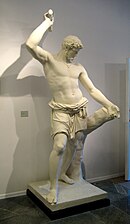art.wikisort.org - Artist
Vasily Ivanovich Demuth-Malinovsky was a Russian sculptor whose works represent the quintessence of the Empire style.
This article relies largely or entirely on a single source. (June 2019) |
Vasily Demut-Malinovsky | |
|---|---|
| Василий Иванович Демут-Малиновский | |
 | |
| Born | March 2, 1778 Saint Petersburg, Russian Empire |
| Died | July 16, 1846 (aged 68) Saint Petersburg, Russian Empire |
| Education | Member Academy of Arts (1807)[1] |
| Alma mater | Imperial Academy of Arts (1800)[1] |
| Known for | Sculpture |
| Awards | |
Biography
He entered the Imperial Academy of Arts at the age of six and studied under Mikhail Kozlovsky for fifteen years. Upon the death of his teacher, he won a competition to design his tomb and departed for Rome to study with Canova. Success came to him with two colossal statues for the Kazan Cathedral in St Petersburg.[1]
In the aftermath of the Russian victory over Napoleon, Demuth-Malinovsky executed a number of patriotic pieces, including a tomb and a large statue of Barclay de Tolly in Estonia. Later Alexander I assigned to him the task of preparing bas-reliefs symbolizing the Neva and the Volga for the Alexander Column on Palace Square.
Demuth-Malinovsky also designed statuary and decorations for other St Petersburg churches, palaces, and public monuments, especially those designed by Carlo Rossi: the General Staff Building, the Bourse, the Admiralty, the Mining Institute, the Egyptian Gate, the Narva Gate, and the Mikhailovsky Palace.
Works
- Sculptural composition on the arch of the General Staff Building
- Andrew the Apostle Kazan Cathedral
- Abduction of Proserpine
- Russian Scaevola
- Monument to Barclay de Tolly (Tartu)
- Bust of Mikhail Muravyov
- Bust of Alexander Suvorov
References
Bibliography
- С. Н. Кондаков (1915). Юбилейный справочник Императорской Академии художеств. 1764-1914 (in Russian). Vol. 2. p. 251.
External links
![]() Media related to Vasily Demut-Malinovsky at Wikimedia Commons
Media related to Vasily Demut-Malinovsky at Wikimedia Commons
На других языках
[de] Wassili Iwanowitsch Demut-Malinowski
Wassili Iwanowitsch Demut-Malinowski (russisch Василий Иванович Демут-Малиновский; * 2. Märzjul. / 13. März 1778greg. in St. Petersburg; † 16. Julijul. / 28. Juli 1846greg. ebenda) war ein russischer Bildhauer des russischen Empire und Hochschullehrer.[1][2][3][4]- [en] Vasily Demut-Malinovsky
[fr] Vassili Demuth-Malinovski
Vassili Ivanovitch Demuth-Malinovski (en russe : Василий Иванович Демут-Малиновский, né en 1779 à Saint-Pétersbourg et décédé le 16 juillet/28 juillet 1846 à Saint-Pétersbourg) est un sculpteur russe dont l'œuvre représente la quintessence du style Empire.[it] Vasilij Ivanovič Demut-Malinovskij
Vasilij Ivanovič Demut-Malinovskij (in russo: Василий Иванович Демут-Малиновский?; 1779 – 16 luglio 1846) è stato uno scultore russo, il cui lavoro rappresenta la quintessenza dello stile impero.[ru] Демут-Малиновский, Василий Иванович
Василий Иванович Демут-Малиновский (2 [13] марта 1778, Санкт-Петербург, Российская империя — 16 [28] июля 1846, там же) — русский скульптор, крупнейший представитель русского классицизма, не раз обращавшийся к теме Отечественной войны 1812 года[1]. Носил фамилию Демут до 37 лет, и лишь в 1816 году прибавил к ней вторую часть — Малиновский[2]. Его монументальные произведения образуют ансамблевое единство с такими классицистическими доминантами Санкт-Петербурга, как Казанский собор, арка Главного штаба, Нарвские ворота. Много работал в области надгробной скульптуры.Другой контент может иметь иную лицензию. Перед использованием материалов сайта WikiSort.org внимательно изучите правила лицензирования конкретных элементов наполнения сайта.
WikiSort.org - проект по пересортировке и дополнению контента Википедии






